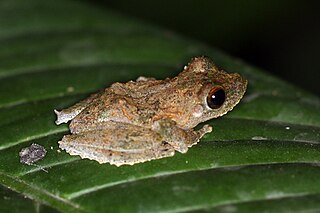
Rhacophorus is a genus of frogs in the shrub frog family (Rhacophoridae)and the related Hylidae make up the true tree frogs. They are found in India, Japan, Madagascar, Africa, and Southeast Asia. Over 40 species are currently recognised.

The Ryukyu Kajika frog, Japanese Buerger's frog, or Japanese stream treefrog is a species of frog in the family Rhacophoridae. It is found in the Ryukyu Islands (Japan) and in Taiwan.
Zhangixalus chenfui, also known as Chinese whipping frog or Chenfu's treefrog, is a species of frog in the family Rhacophoridae endemic to China where it is found in Sichuan, Guizhou, Hubei, and Fujian provinces. Its natural habitats are temperate forests, subtropical moist lowland forests, subtropical moist montane forests, subtropical moist shrubland, freshwater marshes, rural gardens, ponds, and irrigated land. It is not considered a threatened species by the IUCN.
Zhangixalus dorsoviridis, also known as the green-back treefrog, is a species of frog in the family Rhacophoridae that is found in northern Vietnam and southern China (Yunnan). It may be confused with Rhacophorus nigropunctatus. Its natural habitats are subtropical or tropical moist montane forests, freshwater marshes, and intermittent freshwater marshes. It is threatened by habitat loss.

Zhangixalus burmanus is a species of frog in the family Rhacophoridae. It is found in Yunnan in southern China, Nagaland in northeastern India, and northern Myanmar. Its natural habitats are subtropical or tropical seasonally wet or flooded lowland grassland, rivers, freshwater marshes, intermittent freshwater marshes, arable land, rural gardens, ponds, and aquaculture ponds. It is threatened by habitat loss.
Rhacophorus nigropunctatus is a species of frog in the family Rhacophoridae. It is found in China, possibly Myanmar, and possibly Vietnam.

The frilled tree frog, rough-armed tree frog, or Southeast Asian tree frog is a species of frog in the family Rhacophoridae found in Brunei, Cambodia, India, Indonesia, Malaysia, Myanmar, the Philippines, Thailand, and Vietnam. Its natural habitats are subtropical or tropical moist lowland forest, subtropical or tropical swamps, subtropical or tropical moist shrubland, rivers, swamps, freshwater marshes, and intermittent freshwater marshes. It is threatened by habitat loss.
Rhacophorus baliogaster, also known as the belly-spotted frog, is a species of frog in the family Rhacophoridae. It is found in the Central Highlands of Vietnam and the Annamite Mountains of adjacent Laos. Its range probably extends into eastern Cambodia where suitable habitat should be present. The specific name baliogaster is derived from the Greek words balios and gaster, meaning "spotted or dappled belly".
Rhacophorus barisani is a species of frog in the family Rhacophoridae endemic to Indonesia. Its natural habitats are subtropical or tropical moist montane forests, rivers, and freshwater marshes. It is threatened by habitat loss.
Rhacophorus calcaneus is a species of frog in the family Rhacophoridae. It is endemic to Vietnam. It has been extensively confused with Rhacophorus robertingeri, making it difficult to know its true range. Its natural habitats are evergreen forests at elevations of 1,300–2,000 m (4,300–6,600 ft) above sea level. It is threatened by collection for the international pet trade and by habitat loss and degradation caused by rapidly expanding agriculture, including cash crops such as rubber, coffee and tea.

The Chinese flying frog or Chinese gliding frog is a species of tree frog in the family Rhacophoridae found in China, Laos, Burma, and Vietnam. It is also known as Blanford's whipping frog, large treefrog, and Denny's whipping frog.

Rhacophorus edentulus is a species of frog in the family Rhacophoridae endemic to Sulawesi, Indonesia. Its natural habitats are rivers, freshwater marshes, and intermittent freshwater marshes.
Rhacophorus exechopygus is a species of frog in the family Rhacophoridae. It is found in the Central Highlands of Vietnam and in the adjacent Annamite Range in Laos. Its range may extend into northeastern Cambodia where suitable habitat should be present. The specific name exechopygus is derived from the Greek words exechos and pygos (=buttocks), referring to the infra-anal projection characteristic of this frog. Its common names are spinybottom tree frog and Tramlap flying tree frog.
Leptomantis fasciatus is a species of frog in the family Rhacophoridae found in Indonesia and Malaysia. Its natural habitats are subtropical or tropical moist lowland forests and intermittent freshwater marshes. It is threatened by habitat loss.

Feihyla kajau is a species of frog in the family Rhacophoridae found in Indonesia and Malaysia. Its natural habitats are subtropical or tropical moist lowland forests, rivers, freshwater marshes, and intermittent freshwater marshes. It is threatened by habitat loss.

The harlequin tree frog is a species of frog in the family Rhacophoridae found in Brunei, Indonesia, Malaysia, Thailand, and the Philippines. Its natural habitats are subtropical or tropical moist lowland forest, subtropical or tropical moist montane forest, freshwater marshes, and intermittent freshwater marshes. It is threatened by habitat loss.

Rhacophorus reinwardtii is a species of frog in the family Rhacophoridae. It is variously known under the common names of black-webbed tree frog, green flying frog, or Reinwardt's tree frog. It is found in China, Indonesia, Laos, Malaysia, Thailand, and Vietnam, and possibly Brunei and Myanmar. Its natural habitats are subtropical or tropical moist lowland forest, subtropical or tropical moist montane forest, freshwater marshes, and intermittent freshwater marshes. It is not considered threatened by the IUCN.
Robinson's tree frog is a species of frog in the family Rhacophoridae found in Malaysia and Thailand. Its natural habitats are subtropical or tropical moist lowland forests and intermittent freshwater marshes. It is threatened by habitat loss.

Rhacophorus kio is a species of frogs in the family Rhacophoridae.
Rhacophorus robertingeri is a species of frogs in the family Rhacophoridae endemic to Vietnam. First found in the Annamite Mountains of Vietnam, it is now known from mountain areas between Hà Giang or Nghệ An Province in the north and Gia Lai or Bình Thuận Province in the south, depending on the source. This species can be differentiated from its congeners based on the pointed projection at the tibiotarsal articulation, as well as coloration.










